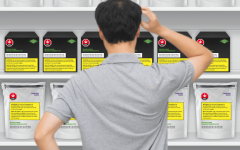Different regulations for cannabis and tobacco packaging is reasonable, says public health expert
In March, Health Canada released a report that summarized the regulation of its recreational cannabis consultation period. Come legalization, packaging for cannabis products must have a single colour with a standardized font style, cannot have “embossed, shiny or metallic” designs on it, and the use of branding and logos will be limited.
Labels must include health messages, as well as the letters ‘THC’ and a red “stop sign” symbol with a cannabis leaf. Packaging will also list the product’s THC and CBD content.
While these federal government regulations may seem strict to some, others believe they are not strict enough. Some tobacco interest groups say there needs to be consistent approaches to the matter of packaging for smoking products.
‘Harm reduction’ messages
Imperial Tobacco Canada reported in a press release in late June that Health Canada’s packaging proposal for cigarettes do not sync up with requirements announced for cannabis products come legalization implementation in October. But others think that the products are different enough to warrant different packaging regulations.
“If you look at the cigarette warnings, they say ‘don’t smoke for this reason,’ says Dr. David Hammond, an associate professor in the School of Public Health & Health Systems at the University of Waterloo. “The interesting thing about the cannabis warnings is that nowhere does it actually say, ‘don’t do cannabis.’ They are almost like harm reduction messages.”
These ‘harm reduction’ messages include warnings against using cannabis while pregnant, driving, if one has or is susceptible to psychosis, if one if underage, or if one has problems with addiction or dependence.
“While regulations for both substances are based on evidence and on the common objective of protecting Canadians — especially youth — they are different products with different risks and require separate approaches,” Health Canada told Global News in an email statement, in response to Imperial Tobacco Canada’s concerns.
The packaging messages for cannabis are sensible warnings, says Hammond. Tobacco kills about 45,000 people a year, unlike cannabis. Therefore, the requirements for cannabis are generally less restrictive, says Hammond.
Cannabis industry vs. public health
“One of the mental shifts we’re going through is that when you think of alcohol, people recognize the difference between use and problematic use. Most people can use it responsibly,” says Hammond. “People are starting to differentiate between use and problematic use [with cannabis].”
Cannabis packages will not be able to show lifestyle advertising, but will still be able to show a brand logo and a different colour from other brands’ cannabis products.
“I think there are people on either side of the spectrum,” says Hammond. “There are people that think they should be going further. There are certainly people—and the [cannabis] industry is one of them—that suggest that there should be fewer restrictions on advertising and labelling.”
From a public health perspective, the packaging regulation aligns nicely with the government’s objectives, says Hammond.
“Those objectives are to provide access to consumers and allow them to have information, but not commercialize the product to the extent that it makes it more appealing for young people to use,” says Hammond.









